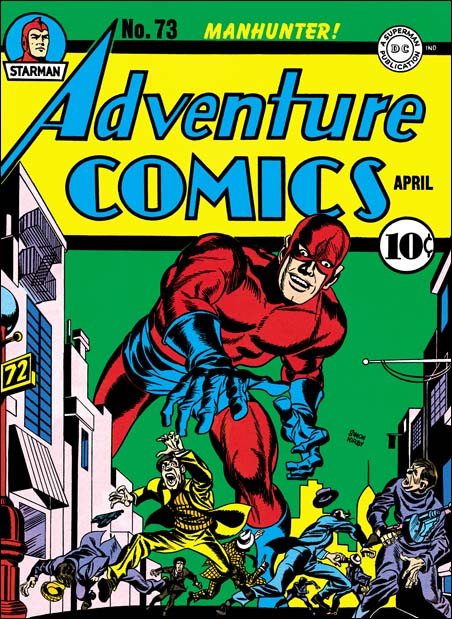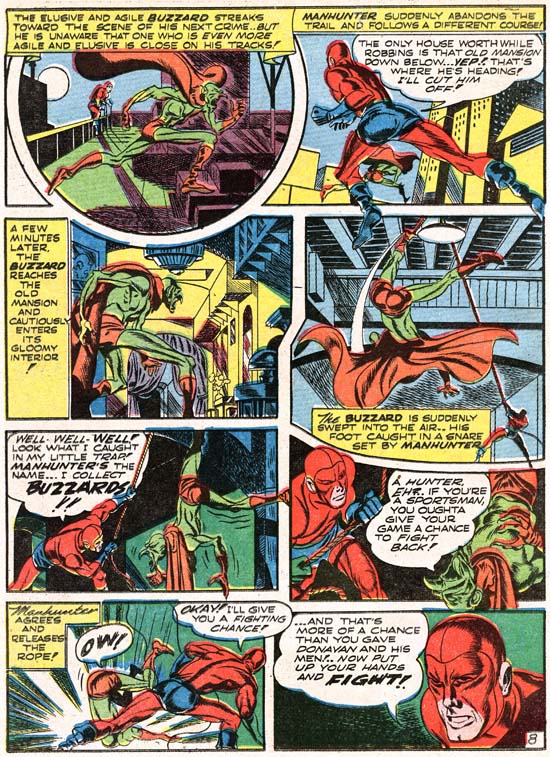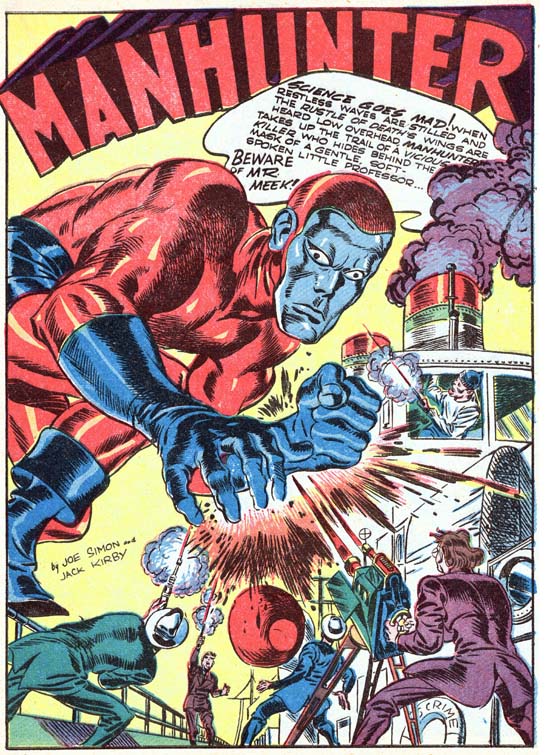
Adventure #72 (March 1942) “The Fish-Men”, art by Ed Moore
There is a gap of a couple of months between when Simon and Kirby left Timely and their first published work for their new gig, DC. In his book, The Comic Book Makers, Joe has said that they did some ghosting at first. I am surprised about that because later attempts by Joe or Jack to copy another artist’s style were not very successful. I would think that by now someone would have identified any ghosting that they did for DC. The first known work for DC was a Sandman story in Adventure #72 (March 1942). Simon and Kirby imparted to Sandman their unique storytelling talents. However Sandman was not their own creation, Simon and Kirby did not even create a new costume for the hero.

Adventure #73 (April 1942) “Buzzard’s Revenge”, art by Jack Kirby
For the next Adventure issue S&K added another feature, Manhunter. This replaced the series Paul Kirk Manhunter. Joe and Jack kept the concept of a big game hunter using his skills to combat crime. Instead of fighting crime as a detective, Simon and Kirby would give their hero a costume and a secret identity. It seems that Joe and Jack wanted to distance themselves further from the previous strip by calling the hero by a new name, Rick Nelson. Probably at the instigation of DC management, Manhunter’s alter ego changed back to Paul Kirk in the next issue’s story and so would remain.

Adventure #73 (April 1942) “Buzzard’s Revenge” page 8, art by Jack Kirby
The name of Manhunter’s secret identity was not the only thing that changed after the first story, there was a costume change as well. Initially Manhunter had a mask which left bare his lower face, very much in the style that Simon and Kirby had used previously for Captain America. This would be replaced afterwards with a blue mask that covers the entire face. It is only the face that is blue, the rest of the head is red like most of the costume. This blue mask is unlike anything that Simon or Kirby did before, and they would never repeat it. There is a separation between the blue mask from the rest of the head gear. The demarcation between the two follows a path about where the hair line would be and then traces down the cheeks. A careful examination reveals that the new costume did not actually start with the second issue, but was used in the first story as well. It is only the coloring used that makes the first story look like it matches the cover art. Chances are when DC noticed the discrepancy between the cover art and the story they asked Simon and Kirby to correct it. On the splash page Manhunter was modified by the addition of a upper face mask. Such a modification probably took too long, and the results were neither matched the cover nor were very satisfactory in its own right. So the rest of the story was altered by the judicious use of color alone.
Aside from the issues of the costume and secret identity, everything for Manhunter was in place right from the start. In Captain America the origin story seemed like something that S&K had to get over with as quickly as possible so that the real tales could be presented. With Manhunter Simon and Kirby handled the origin better, integrating it into the first story quite well. Kirby continued drawing with devices he had adopted in Captain America, variable shaped panels, figures that extended beyond panel boarders, exaggerated perspectives, outrageous running strides, and what would become a Kirby trademark, his socko punches. Jack’s pencils seem better, as if he was now fully in control of what he was doing. But of course Kirby’s art always seem to change and improve as he was never satisfied to rest on his former achievements. For me it was with the early DC work and the Harvey covers that the Simon and Kirby unique artistic vision first congealed. An important part of this was their forging a unique inking style. You can see suggestions of it in Captain America, but perhaps because of all the different hands used to produce that comic it all appeared a bit piece meal. With the DC and Harvey work the brushwork would be bold yet sensitive.
It is not just the art that makes Simon and Kirby productions so great, it is the writing as well. Simon and Kirby managed to leave their unique touch on the Manhunter stories. There was nothing else at the time as exciting as Manhunter in Adventure Comics, or for that matter any of the DC comics, well except of course for the Sandman stories. Manhunter was matched against crime lords, evil scientists, jewel thieves, Nazi spies and escaped convicts. No matter what foe Manhunter pitted himself against he would manage to track them down, although sometimes he would end up being hunted in return. They were all fast pace adventures and in my opinion great reads.

Adventure #75 (June 1942) “Beware of Mr. Meek”, art by Jack Kirby
There was one aspect about Manhunter that Joe and Jack seemed a little uncomfortable with. Simon and Kirby preferred to give their heroes a sidekick, so that they would have someone to talk to as Joe would explain. Simon and Kirby’s solution to this problem in Manhunter was to provide a different sidekick as the need aroused. In “Scavenger Hunt” (Adventure #73) Manhunter teams up with a young man trying to prove his worth to his would be love. For “Beware of Mr. Meek” (Adventure #75) the sidekick is of all things a beautiful jewel thief. A boy scout helps the temporarily blinded Manhunter follow the crooks’ trail in “The Legend of the Silent Bear” (Adventure #76). In “The Stone of Vengeance” (Adventure #77) a shoe shine boy becomes involved in Manhunter’s case against some murderous jewel thieves. The lady in “The Lady and the Tiger” is effectively Manhunters sidekick in Adventure #78. Finally in “Man Trap Island” (Adventure #80) he teams up with a young Indian lad to combat escape convicts. Only in the origin story and “Cobras of the Deep” (Adventure #79) does Manhunter truly work alone.
Simon and Kirby only did eight Manhunter stories. The feature did continue but under much less talented hands. Unfortunately Manhunter was not the sort of character that could continue to be successful without the Simon and Kirby touch. Frankly I am surprised it made it as far as Adventure #92 (June 1944). Reprints of most of the S&K Manhunter stories appeared as backup features for some of Kirby’s DC comics in the early ’70s. Jack would also do a retro version of the Manhunter in 1975 (1st Issue Special #5). These ’70s work must have had an impact because over the years DC would publish a variety of Manhunter avatars, the latest being a female version. With Manhunter’s continued significance in DC continuity I would have thought that a tradeback edition of the original Simon and Kirby stories would be a no brainer. Yet despite all the archive editions published, DC seems reluctant to reprint Manhunter or any of the other Simon and Kirby creations. I wonder why?

